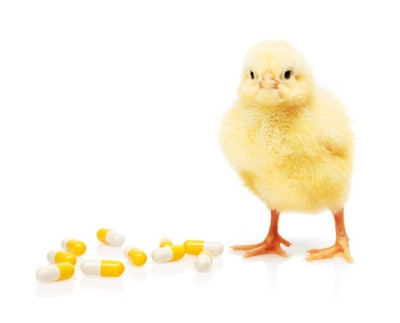
Antibiotics remain essential in treating disease, but only one tool to ensure animal health and should be used in conjunction with other control measures to prevent antimicrobial resistance.
The four R’s approach — review, reduce and replace responsibly — is an effective way to achieve optimal performance while lowering antibiotic usage.
Review
In order to successfully reduce overall antibiotic usage and requirements, it is important to identify the reasons for use, the amount being used and the routes of administration.
Therapeutic antibiotics should only be used reactively once bacterial disease is positively diagnosed to ensure that antibiotics are used only when completely necessary. Antibiotic methods of administration should be reviewed to ensure they are completed as per instructions from a veterinarian, in the correct dose and for an appropriate duration.
Reduce
There are many ways in which the number of animals requiring antibiotic treatment can be reduced. This is most commonly achieved through the implementation of a biosecurity plan, which should ensure efficient management and the highest nutritional quality and hygiene of feed and water, thus lowering the potential exposure to disease challenge.
- Biosecurity: Individual units or businesses should have a well-established and agreed-upon, site-specific biosecurity plan created by the agricultural manager and veterinary professional. It is of vital importance that all employees, visitors and contractors follow this plan and any inputs or outputs from the site are monitored which will enable the source of any potential contamination to be identified.
There are also steps which can be taken to reduce the risk of disease, e.g. employees should not come into contact with any swine or bird species prior to entering their working environment, suitable personal protective equipment should be provided to all personnel, and sanitization stations, such as footbaths and hand washing facilities, should be maintained.
The showering of staff before entering animal housing and before leaving the site is recommended.
- Management: Preventing disease challenges caused by poor animal management and husbandry is fundamental to the success of reducing the impact of antimicrobial resistance.
Simple animal husbandry techniques, to meet animal needs and requirements, can improve overall livestock health and performance, e.g. ensuring appropriate stocking densities and housing with adequate ventilation is as critical, as is ensuring hygienic feed, bedding and water sources. In addition to this, many wild birds, waterfowl and small mammals can spread diseases and therefore their presence within farming sites must be minimized and prevention strategies put in place.
The use of appropriate vaccination programs are highly effective additions in improving herd, flock and batch health. These can help to minimize the requirement for antibiotics through the prevention and control of infectious diseases in livestock production systems.
Finally, it is important for livestock producers to implement the regular testing of the feed, environment and indeed the animals themselves for disease. All testing programs implemented should be regularly reviewed and the timing and efficacy of programs evaluated. Although testing for different diseases on a regular basis is important in maintaining a proactive, preventative approach to livestock production, the prompt identification, diagnosis and treatment of sick animals can also help to reduce a farm’s reliance on antibiotics.
- Ensure nutritional quality: Feed is a major attractant for pests and can be contaminated by a range of pathogens. There are a wide variety of treatments available for feed to ensure it is of the highest quality and free from pathogens, mycotoxins, mold and bacteria. Preventing the intake of potentially pathogenic bacteria at the raw material level is fundamental in ensuring productive, healthy and efficient livestock which are capable of meeting their genetic potential and have a decreased requirement for antibiotics.
In addition to feed, water quality is also important to consider. Water intake has a direct impact on feed consumption and should therefore be of the highest possible quality to ensure genetic growth potentials are met. Water intake in animals should be closely monitored as this can be a key indicator of an issue especially when water quality is low. Water from ground sources should be regularly tested to ensure that drinking water mineral levels are appropriate for livestock and also water storage tanks and drinker lines should be regularly cleaned.
Replace responsibly
Once antibiotic usage has been appropriately reviewed and reduced, other natural feed additives or possible alternatives can be investigated and utilized to maintain animal health and performance. There are a wide range of products and solutions available which work in harmony with the natural aspects of the animal’s biology to promote healthy growth in antibiotic reduction systems.
Many of these companies responsibly review, reduce and replace the need for antibiotics in a sustainable, natural way, offering a broad portfolio of innovative feed additive technologies to implement the four R’s approach to antibiotic usage.
















